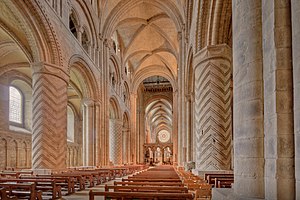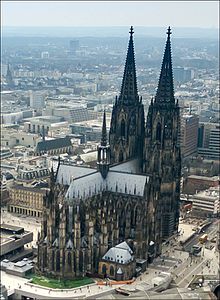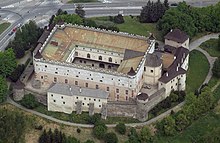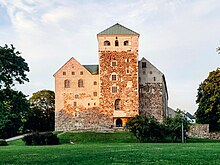Medieval architecture
 From Wikipedia - Reading time: 11 min
From Wikipedia - Reading time: 11 min

Medieval architecture was the art of designing and constructing buildings in the Middle Ages. Major styles of the period include pre-Romanesque, Romanesque, and Gothic. The Renaissance marked the end of the medieval period, when architects began to favour classical forms. While most surviving medieval constructions are churches and military fortifications, examples of civic and domestic architecture can be found throughout Europe, including in manor houses, town halls, almshouses, bridges, and residential houses.
Styles
[edit]Pre-Romanesque
[edit]
The pre-Romanesque period of medieval architecture lasted from the beginning of the Middle Ages (around 500AD) to the emergence of the Romanesque style in the 10th century. Much of the notable architecture from the period comes from France and Germany, under the Merovingians and the Carolingians and the Ottonians. Nonetheless, other regions have strong architectural heritage from this period, including Iberia (especially in Asturias), Croatia, and Great Britain. In Lombardy, the pre-Romanesque style included many Romanesque features and is therefore known as the First Romanesque.
Romanesque
[edit]Romanesque, prevalent in medieval Europe during the 11th and 12th centuries, was the first pan-European style since Roman Imperial architecture and examples are found in every part of the continent. The term was not contemporary with the art it describes, but rather, is an invention of modern scholarship based on its similarity to Roman Architecture in forms and materials.[1] Romanesque is characterized by a use of round or slightly pointed arches, barrel vaults, and cruciform piers supporting vaults. Romanesque buildings are widely known throughout Europe.
The Romanesque style is sometimes called Anglo-Norman, though it continues under the Angevin and Plantagenet rulers. Motifs of Roman origin were common to Norman and Anglo-Saxon architectural styles. Though usually classed broadly as "Romanesque", the period of architecture can now be divided into two stages. The first stage from 1070 A.D. to 1100 A.D. saw the style emerge during the rebuilding of many great churches, Full boxes, and monasteries (surviving examples include the Durham Cathedral, Norwich Cathedral and the Peterborough Cathedral). The second stage lasted from 1100 A.D. to 1170 A.D. when many smaller churches were built and renovated. During this time, the style became more detailed and ornamental. Identifying these latter churches is made difficult due to something called the Saxo-Norman overlap, where many Anglo-Saxon aspects are present in the masonry. The Church at Kilpeck is identified as 12th century based on its shallow and flat buttresses, emphatic corbel table and apse.[2]
Gothic
[edit]The various elements of Gothic architecture emerged in a number of 11th and 12th century building projects, particularly in the Île de France area, but were first combined to form what we would now recognise as a distinctively Gothic style at the 12th century abbey church of Saint-Denis in Saint-Denis, near Paris. Verticality is emphasized in Gothic architecture, which features almost skeletal stone structures with great expanses of glass, pared-down wall surfaces supported by external flying buttresses, pointed arches using the ogive shape, ribbed stone vaults, clustered columns, pinnacles and sharply pointed spires. Windows contain stained glass, showing stories from the Bible and from lives of saints. Such advances in design allowed cathedrals to rise taller than ever.
Functions
[edit]Religious architecture
[edit]
The architecture of religious buildings depended on the religion it served, the region it was located in, and the style during the time. Although it is common to see in many floor plans of medieval religious structures a nave-the central part of the church building, transepts-isle crossing the nave, and an altar located on the east side forming the shape of the Latin cross.[3] The buildings with this floor plan are considered cruciform churches, which is seen in a large amount of cathedrals and churches in the Romanesque and Gothic styles across Europe. Many religious buildings also had sacred elements such as relics and reliquaries for there patrons and far-off travelers to see that tells the story of saints and other biblical narratives.[4]

The different styles during the middle ages caused churches to have different design elements throughout the time period. In the Romanesque period a common religious building was the basilica.[5] This structures were tall with a rather simple design of a nave, an alter, transepts, and clerestory windows. Gothic cathedrals had features such as stain glass, ribbed vaults, tall piers, buttresses, and pinnacles their structure is very unique due to these details. The cathedrals are also identifiable due to their height, stone structure, and wooden roofs.[6]Some examples of these religious structures are St. Peter's Basilica, and Cologne Cathedral.
Religious structures during the medieval period had a large amount of meaning behind the elements they contained. Many columns or portals for religious buildings tell a story or have some kind of religious symbolism. Some of the commonly displayed biblical narratives are the creation story of Adam and Eve, and judgement day invoking visuals of sin and fear for the viewer.[7] A few examples of these elements are west tympanum of Saint-Lazare[8], and Lorenzo Ghiberti’s Gates of Paradise.[9]
Military architecture
[edit]

Surviving examples of medieval secular architecture mainly served for defense, these include forts, castles, tower houses, and fortified walls. Fortifications were built during the Middle Ages to display the power of the lords of the land and reassure common folk in their protection of property and livelihood. [10]In the early Middle Ages, fortifications were made from wood and earth, these were called Motte and bailey castles. These consist of a stockade or palisade surrounding an enclosed courtyard and man-made mound. This fortification acted as a passive obstacle that potential enemies would have to face to attack the civilization. However, this method of fortification had its downside including being vulnerable to fires so more methods of fortification were created.
Military architecture began to start being created with stone in the 11th century, it was also used to indicate wealth and power of the are protected with it. Stone was much more durable and provided better defense for the people. They also began to adopt the use of cylindrical ground plans. There were many benefits to a cylindrical shape, it reduced blindspots, they were more resistant, and was especially fireproof.[11] Some examples of cylindrical fortifications are the gate towers at Harlech Castle and the Tour des Pénitents.
Medieval Fortifications also displayed many different defensive elements including, hoardings, loopholes or crosslets, and moats. Hoarding and loopholes were both beneficial for the archers or missile throwers, allowing them to see their targets better. Windows gained a cross-shape for more than decorative purposes, they provided a perfect fit for a crossbowman to shoot invaders from inside safely. Moats were used as a defensive mechanism for keeping attackers further away from the fort, while most were kept dry, moats were much more effective when wet.[12]
Civic architecture
[edit]While much of the surviving medieval architecture is either religious or military, examples of civic and even domestic architecture can be found throughout Europe. Examples include manor houses, town halls, almshouses and bridges, but also residential houses.
Regions
[edit]Central Europe
[edit]
Byzantine Empire
[edit]Bulgarian Empire
[edit]
Scandinavia
[edit]
Kievan Rus
[edit]See also
[edit]- Medieval Serbian architecture
- List of medieval stone bridges in Germany
- List of medieval bridges in France
References
[edit]- ^ Bleeke, Marian (2012). "Romanesque". Studies in Iconography. 33: 257–267. ISSN 0148-1029. JSTOR 23924288.
- ^ Cannon, Jon (10 July 2014). Medieval Church Architecture. Bloomsbury. ISBN 9780747815327.
- ^ Bucher, François (1972). "Medieval Architectural Design Methods, 800-1560". Gesta. 11 (2): 37–51. doi:10.2307/766593. ISSN 0016-920X. JSTOR 766593.
- ^ Bonser, Wilfrid (1962). "The Cult of Relics in the Middle Ages". Folklore. 73 (4): 234–256. ISSN 0015-587X. JSTOR 1258503.
- ^ Müller, Valentin (1937). "The Roman Basilica". American Journal of Archaeology. 41 (2): 250–261. doi:10.2307/498415. ISSN 0002-9114. JSTOR 498415.
- ^ Mark, Robert (1972). "The Structural Analysis of Gothic Cathedrals". Scientific American. 227 (5): 90–101. Bibcode:1972SciAm.227e..90M. doi:10.1038/scientificamerican1172-90. ISSN 0036-8733. JSTOR 24922917.
- ^ Alexander, Jonathan J. G. (1993). "Iconography and Ideology: Uncovering Social Meanings in Western Medieval Christian Art". Studies in Iconography. 15: 1–44. ISSN 0148-1029. JSTOR 23923571.
- ^ Gislebertus, French, Romanesque. "Church of Saint Lazare, Autun: Apocalypse (Last Judgment)". Art History Survey Collection.
{{cite journal}}: CS1 maint: multiple names: authors list (link) - ^ Ghiberti, Lorenzo, Florentine. "Baptistry of San Giovanni, Florence: Gates of Paradise - East Doors". Ghiberti's Gates of Paradise Collection – via JSTOR.
{{cite journal}}: CS1 maint: multiple names: authors list (link) - ^ Warner, Philip (1971). The medieval castle: life in a fortress in peace and war. New York: Taplinger Pub. Co. ISBN 978-0-8008-5186-6.
- ^ Kaufmann, Joseph Erich; Kaufmann, Hanna Wanda (2001). The Medieval fortress: castles, forts and walled cities of the Middle Age. Conshohocken (Pa.): Combined Publishing. ISBN 978-1-58097-062-4.
- ^ Oulmas, Mohand; Abdessemed-Foufa, Amina; Avilés, Angel Benigno Gonzalez; Conesa, José Ignacio Pagán (January 2024). "Assessing the Defensibility of Medieval Fortresses on the Mediterranean Coast: A Study of Algerian and Spanish Territories". ISPRS International Journal of Geo-Information. 13 (1): 2. doi:10.3390/ijgi13010002. hdl:10045/139477. ISSN 2220-9964.
Further reading
[edit]- Braun, Hugh, An Introduction to English Mediaeval Architecture, London: Faber and Faber, 1951.
- "Building the House of God: Architectural Metaphor and The Mystic Ark," Codex Aquilarensis: Revista de arte medieval (2016)
- Fletcher, Banister; Cruickshank, Dan, Sir Banister Fletcher's a History of Architecture, Architectural Press, 20th edition, 1996 (first published 1896). ISBN 0-7506-2267-9. Cf. Part Two, Chapter 13.
- Hillson, J., Buchanan, A., Webb, N , Digital Analysis of Vaults in English Medieval Architecture, London: Taylor & Francis (2021).
- Rudolph, Conrad, "Building-Miracles as Artistic Justification in the Early and Mid-Twelfth Century," Radical Art History: Internationale Anthologie, ed. Wolfgang Kersten (1997) 398–410.
- Rudolph, Conrad, "The Architectural Metaphor in Western Medieval Artistic Culture: From the Cornerstone to The Mystic Ark," The Cambridge History of Religious Architecture, ed. Stephen Murray (2016).
- Rudolph, Conrad, "Medieval Architectural Theory, the Sacred Economy, and the Public Presentation of Monastic Architecture: The Classic Cistercian Plan," Journal of the Society of Architectural Historians 78 (2019) 259–275.
 KSF
KSF